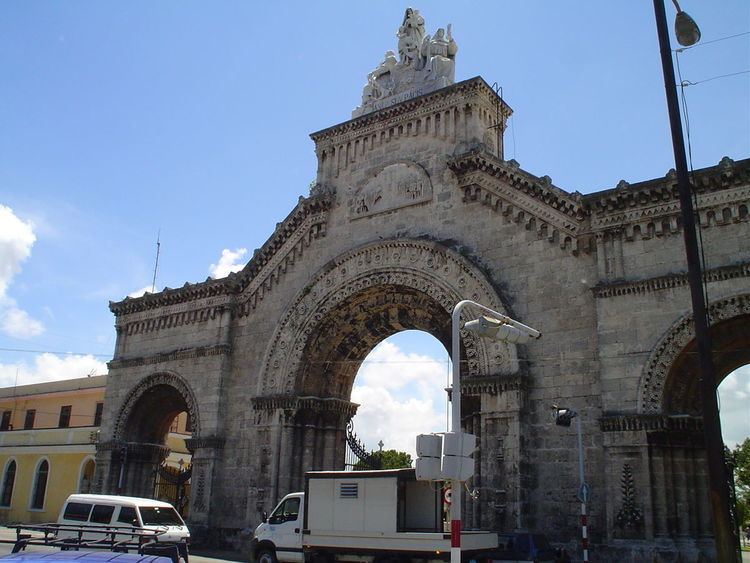Established 1876 Country Cuba No. of graves 800,000 Address Calle 12, La Habana, Cuba Phone +53 7 8321057 Architect Eugenio Rayneri Piedra | Location Vedado, Havana Size 140 acres (57 ha) No. of interments over 1 million Founded 1876 Number of graves 800,000 | |
 | ||
Hours Open today · 8AM–5PMThursday8AM–5PMFriday8AM–5PMSaturdayClosedSundayClosedMonday8AM–5PMTuesday8AM–5PMWednesday8AM–5PM Burials Máximo Gómez, Alejo Carpentier, José Miguel Gómez Similar El Capitolio, Morro Castle, Malecón - Havana, Old Havana, Gran Teatro de La Habana | ||
La milagrosa colon cemetery havana cuba
The Colon Cemetery, or more fully in the Spanish language Cementerio de Cristóbal Colón, was founded in 1876 in the Vedado neighbourhood of Havana, Cuba on top of Espada Cemetery. Named for Christopher Columbus, the 140 acre (57 ha) cemetery is noted for its many elaborately sculpted memorials. It is estimated that today the cemetery has more than 500 major mausoleums, chapels, and family vaults.
Contents
- La milagrosa colon cemetery havana cuba
- Mausoleum in cristobal colon cemetery havana cuba
- Overview
- Notable interments
- References
Mausoleum in cristobal colon cemetery havana cuba
Overview
Colon Cemetery is one of the great historical cemeteries of the world, and is generally held to be the most important in Latin America in historical and architectural terms, second only to La Recoleta in Buenos Aires. Prior to the opening of the Colon Cemetery, Havana's dead were laid to rest in the crypts of local church catacombs and then, beginning in 1806, at Havana's newly opened Espada Cemetery. When locals realized there would be a need for a larger space for their community’s dead (due to an 1868 cholera outbreak), planning then began for the Colon Cemetery.
It was built by the Galician architect Calixto Arellano de Loira y Cardoso, a graduate of Madrid’s Royal Academy of Arts of San Fernando, and who became Colón’s first occupant when he died before his work was completed. Yet for all its elegance and grandeur Colon Cemetery conceals as much as it displays. Empty tombs and desecrated family chapels disfigure the stately march of Cuban family memorials even in the most prominent of the avenues, and away from the central cross-streets, ruin. Many of these are the tombs of exiled families, whose problems with caring for their dead have been complicated by residence in new countries.
The first impact of Colon Cemetery is a seemingly endless succession of tombs blinding white in the midday heat, few shade trees and nowhere to sit. In front of the main entrance, at the axes of the principal avenues Avenida Cristobal Colón, Obispo Espada and Obispo Fray Jacinto, stands the Central Chapel apparently modelled on Il Duomo in Florence. On every side rectangular streets lead geometrically to the cemetery’s 56 hectares, designed by Loira to define the rank and social status of the dead with distinct areas, almost city suburbs: priests, soldiers, brotherhoods, the wealthy, the poor, infants, victims of epidemics, pagans and the condemned. The best preserved and grandest tombs stand on or near these central avenues and their axes.
Colon Cemetery has a 75-foot (23 m)-high monument to the firefighters who lost their lives in the great fire of May 17, 1890. As baseball is a leading sport in Cuba, the cemetery has two monuments to baseball players from the Cuban League. The first was erected in 1942 and the second in 1951 for members of the Cuban Baseball Hall of Fame.
In February 1898, the recovered bodies of sailors who died on the United States Navy battleship Maine were interred in the Colon Cemetery. In December 1899 the bodies were disinterred and brought back to the United States for burial at Arlington National Cemetery.
Also buried here are three British Commonwealth servicemen who are commemorated by the Commonwealth War Graves Commission; a Canadian Army officer of World War I, and a Royal Engineers officer and Royal Canadian Navy seaman of World War II. The remains of the casualties are located in the mausoleum of the Anglo-American Welfare Association, with the names inscribed on the central memorial which also forms the entrance to the underground ossuary.
With more than 800,000 graves and 1 million interments, space in the Colon Cemetery is currently at a premium and as such after three years remains are removed from their tombs, boxed and placed in a storage building.
